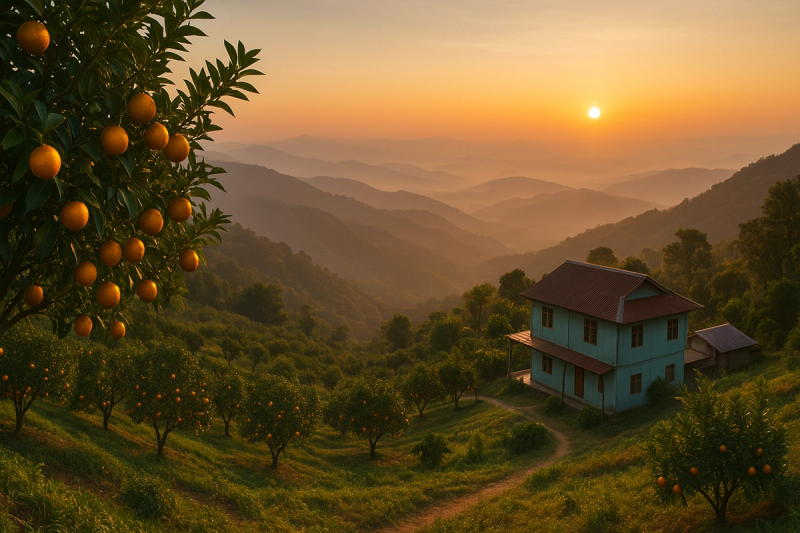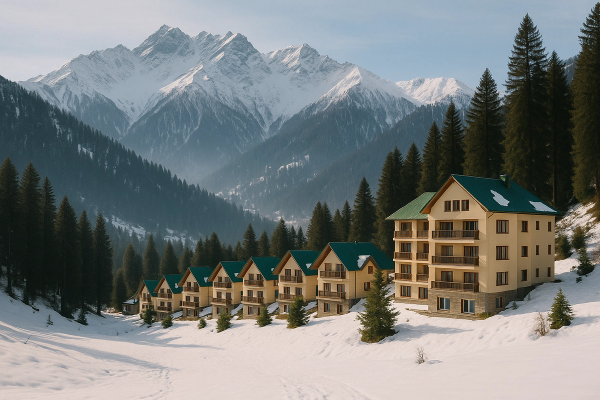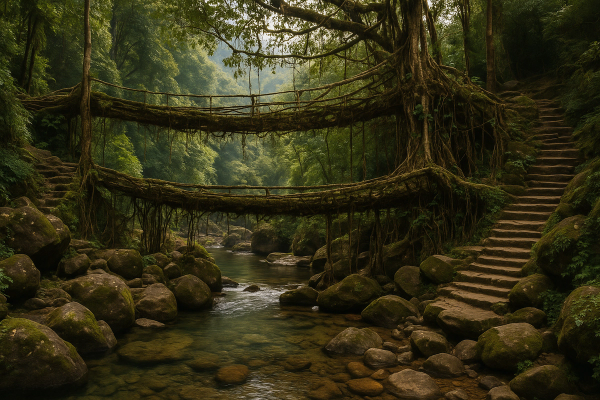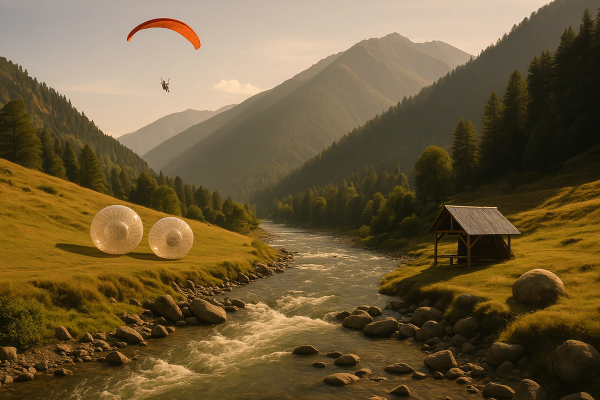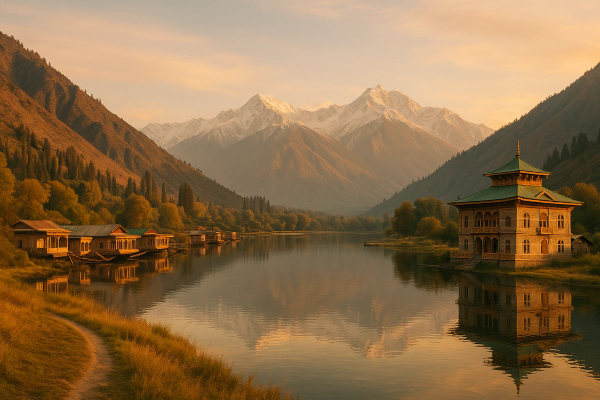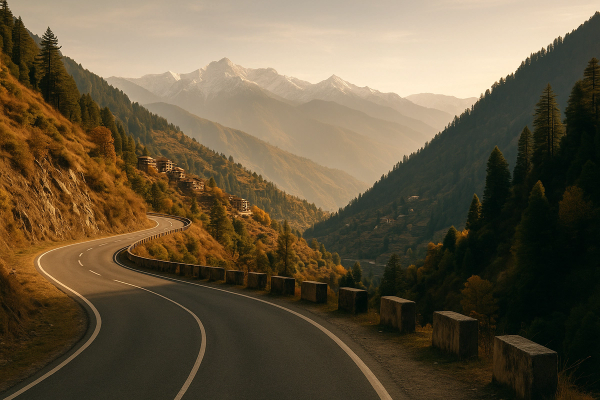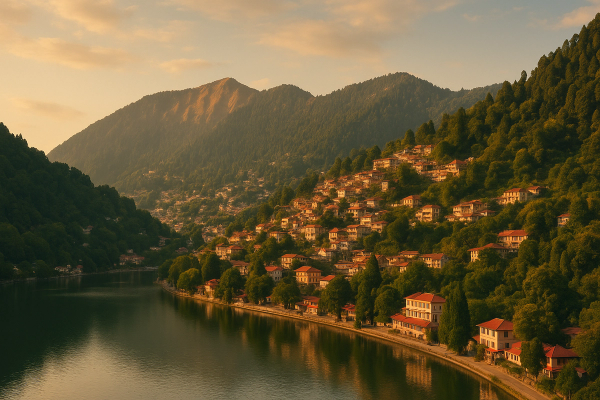Jampui Hills, Tripura: Oranges, Sunrise Views & Homestays — a real trip, some messy notes, and everything you actually need#
I finally did it. Packed my tiny backpack, got on a very not-glamorous bus, and went up to Jampui Hills. If you’re like me — a middle-class desi traveler who likes long chai breaks and random chats with locals — this place will get under your skin in the best way. Tripura is underrated anyway, and Jampui? It’s that slow, soft kind of hill station where you wake up to mist, eat oranges for breakfast, and somehow feel like you’ve lived there in a past life. I didn’t go with any grand plan tbh. I wanted sunrise views, homestays, and oranges. And I got it… plus a lot of small, sweet unexpected stuff, like stories from a Mizo auntie who told me which ridge to stand on to see the sunlight hit the valley first. Honestly, photos don’t capture that exact hush at dawn when the hills are just… glowing.¶
Where is Jampui Hills and why it’s special (beyond the oranges)#
Jampui Hills sits in North Tripura, close to the Mizoram border, spread across villages like Vanghmun, Sabual, Phuldungsei, Behliangchhip. Lushai/Mizo families have lived here forever, and that’s what makes it feel different from your typical touristy place. It’s at about 900–1000 meters (the highest peak in Tripura, Betlingchhip, is here at around 929 m), so not crazy high-altitude, but the air and the light — they’re clean and kind of addicting. People know Jampui as the “orange hills,” yes, but it’s also sunrise central. The ridgelines run just so, so the first light splashes across layers of blue and green. Sounds dramatic, but trust me, you’ll end up waking at 4:45 am without complaining. Also, it’s quiet. No honking, no Insta influencer chaos, just birds and roosters and the occasional shared jeep chugging around a bend.¶
How I reached (and all transport options that actually work)#
I started from Agartala because flights are easiest to Maharaja Bir Bikram Airport. From there you have two routes: go by train or bus to Dharmanagar/Kumarghat, then onward by shared jeeps to Kanchanpur and Vanghmun. Or straight road if you’ve hired a car. I did Agartala to Dharmanagar by train (North East Frontier Railway — cheap and pretty reliable), then a shared Sumo to Kanchanpur, and finally another one uphill to Vanghmun. Total time? Around 8–10 hours if everything lines up, and if you’re not stuck behind a truck on a one-lane hairpin road. Costs were roughly: train 200–400 ₹, shared jeeps 150–300 ₹ per leg, depending on your bargaining mood and how crowded it is. Tripura Road Transport buses also do Agartala–Dharmanagar–Kanchanpur routes, but schedules are... flexible. Post-monsoon, road repairs happen and you might see patches of fresh blacktop and then a muddy bit. Late 2024 and early 2025, the road up from Kanchanpur has been generally fine, but listen to locals about landslide-prone bends right after heavy rain. Pro tip: reach Kanchanpur before 3 pm, otherwise getting a jeep uphill gets annoying. Also, fuel pump is at Kanchanpur, so if you’re driving, don’t be brave with the tank.¶
Staying there: homestays vs tourist lodges (what I booked, what I’d book again)#
I stayed in a homestay near Vanghmun run by a Mizo family — two rooms, wooden floors, hot tea always. 1200–1600 ₹ per night for a clean room with shared bathroom, and home-cooked dinner that tasted like a memory. Tripura Tourism also runs the Eden/Tejashwini-style tourist lodges (names vary locally, people will just say “tourist lodge near Vanghmun”), typically 1500–2500 ₹ depending on the room category. Booking is sometimes online through Tripura Tourism’s official portal, but I had better luck calling the lodge directly the day before. In peak orange and sunrise season (Oct–Feb) rooms fill up on weekends. Carry cash — UPI works in Kanchanpur shops, but network can be moody in the hills. Homestays are honestly the way to go if you want morning rice porridge and stories about how the orange harvest used to be bigger back in the day. In 2025, community-run stays got more popular here, not like fancy resorts, but warm and fuss-free.¶
Sunrise hunting: the viewpoints that felt like cinema#
Ok, sunrise chasing here is not hype. My first morning, I followed the homestay owner’s son to a ridge just before Betlingchhip peak. The watch tower near the top is the postcard spot, but even the lower spur has this wider view of rippling hills and tiny valleys. On clear days you can see hints of Mizoram’s folds to the east. We reached by 5:15 am. It was chilly — sweater and a light windcheater did the job. The sky changed colors in layers like someone was painting with patience. That very quiet clink of somebody’s thermos opening nearby. Birds starting up. And then boom — the whole valley in peach. The classic spots: Betlingchhip watch tower, the viewpoint past Vanghmun bazar road, and small knolls near Sabual. Don’t overthink it, ask any shop guy, they’ll point at the exact ridge. Best days are right after rain when air is squeaky clean. On misty mornings you still get drama — sea of clouds type things.¶
Oranges — what’s the scene now? Are they still the famous Jampui oranges?#
Short answer: yes and no. Jampui was legendary for oranges, and the Orange & Tourism Festival used to be huge in November. Recent years saw fluctuating harvests because of crop disease and weird rain patterns. You’ll still find sweet oranges in season, just maybe not massive quantities like old times. People told me the horticulture department has been nudging farmers toward mixed varieties — Kinnow, Nagpur, some newer grafts — and better pruning. If the harvest looks good, folks do a small local mela too, and sometimes the official festival happens, sometimes it doesn’t. It’s not predictable, so don’t plan your entire trip around the festival date. Still, you can walk through small orchards, buy fruit from the roadside (80–120 ₹ a dozen when supply’s healthy), and taste fresh orange juice that’s a little tangy but wow. Bonus: you can also catch pineapples, papayas, and bananas depending on harvest. Support local — the farmers will tell you which tree tastes sweeter than the one next to it. My favorite thing was orange peel chutney at dinner, weirdly addictive.¶
Eat like you live there: homestyle Tripura + Mizo plates#
Food here is wholesome and not fancy. In homestays you’ll get rice, boiled veggies, dal, and a main — chicken, pork, or fish depending on what you eat. A Mizo-style “bai” with seasonal greens and mild broth hit that perfect comfort spot on a chilly evening. Tripura’s own flavors pop up too — berma (fermented fish) shows up in chakhwi or mosodeng if your host cooks it. If you’re vegetarian, totally doable. They make bamboo shoot curries, pumpkin, beans, local leafy mixes. Breakfast was thick tea, eggs, sometimes roti, sometimes rice porridge. Try smoked pork if you eat meat — the texture is unique and it’s seasoned lightly. And I swear, oranges with salt and chilli right after sunrise? Chef’s kiss. I carried my own coffee sachets because I’m that person, but tea was better anyway. There’s a tiny bakery near Vanghmun that sells dry cake and cream rolls (proper desi mountain nostalgia). Prices are normal, not tourist trap. Do carry snacks since shops close early.¶
Things to do (beyond sunrise and oranges)#
- Walk the village trails: short strolls turn into long chats. People are friendly if you greet first.
- Climb to Betlingchhip peak: it’s not hardcore trekking, but shoes with grip help on damp days.
- Visit small orchards: ask before entering, buy fruit directly, don’t pluck without permission.
- Catch local dances or songs if there’s a community program. Not every day, but ask around.
- Sit at the roadside viewpoint for sunset. Everyone talks about sunrise, but evenings are gold too.
- Birdwatch casually. I’m no birder, but even I spotted drongos and parakeets. Bring binoculars if you have.
Best time to visit, weather moods, and what to pack#
October to February is peak, with crisp mornings and clear skies. Sunrises are stunning, and oranges typically show up in late Oct–Nov if harvest is good. March–April turns warm, still fine if you like slow travel and less crowd. Monsoon (June–September) is tricky — beautiful mist and green, but rains can trigger landslides and road delays. Wear layers: a light fleece, windcheater, and a cap for sunrise. Good walking shoes, not flip-flops, please. Carry a small torch — streetlights are not a given. Umbrella or rain jacket even in winter because mountain weather likes drama. Also mosquito repellent (evenings), basic meds, and a thermos bottle to fill with boiled water from the homestay kitchen. Network can be patchy on ridges; offline maps are smart. Dude, don’t forget sunscreen. Hills sun will crisp you softly and you won’t notice till later.¶
Money, mobile, and safety — the practical bits (updated info)#
ATMs are in Kanchanpur and Dharmanagar. In Vanghmun, don’t assume cards or UPI will work all the time. Cash is king. Jio and Airtel both worked for me but dropped randomly near the peak. BSNL had decent calls in certain pockets. As of late 2024 and into 2025, the area has been safe for travelers — people are warm, and I didn’t face any nonsense. Still, don’t walk off toward border posts or deep forest at night. Monsoon means slippery paths and occasional leeches in grassy bits, so check ankles in rainy months. Healthwise, boiled water only, and keep rehydration salts handy if you’re on local buses a lot. No ILP needed for Indians in Tripura. If you’re foreign national, check the latest advisory for PAP/RAP, because rules can be quirky for certain NE spots. For current updates, locals actually know best, but Tripura Tourism’s social handles are reasonably active. Also, tell your homestay your sunrise plan. They worry if you vanish at 4:45 am, lol.¶
Costs — the honest budget breakdown for a short trip#
My 3-day trip roughly cost: stay 1200–1800 ₹ per night (homestay), food 250–500 ₹ a day (simple meals), transport from Agartala via train and jeeps around 800–1200 ₹ one-way. Add 500–800 ₹ misc for snacks, fruit, and tea treats. If you hire a private car from Agartala, per day rates are 4500–6000 ₹ plus fuel depending on season and vehicle. Entry fees are minimal — some viewpoints or towers might ask for 10–20 ₹ maintenance donation. Tips to homestay cooks are appreciated, even 100–200 ₹ feels nice. None of this is luxury, but it’s comfortable. You can totally do Jampui under 8–12k for 3–4 days if you keep it simple.¶
A morning that made me soft (and why it matters)#
So, my favorite morning. We woke before 5, and the homestay auntie had already set us tea in these tall steel glasses. Walked 15 minutes up a dark lane, the kind where your feet remember their own steps because the mind is sleepy. No traffic, just tiny frogs somewhere. Two local teenagers joined us with a bluetooth speaker but never played anything. Respect, man. We reached a sloping field — not a big viewpoint, just a gentle rise — and watched the ridge blush. That first line of light hit the orange trees and the wet leaves blinked. I can’t explain it right but something slows down in your brain. You breathe. The boys just said, “beautiful, no?” That’s it. Not epic. But perfect. That’s Jampui’s vibe. Nothing tries too hard. You relax.¶
If you love planning, here’s one flexible itinerary that worked#
- Day 1: Agartala to Dharmanagar/Kanchanpur, then up to Vanghmun. Check-in, walk the bazar lane, find your sunrise spot by chatting with 2–3 locals. Early dinner.
- Day 2: Sunrise at Betlingchhip ridge or the watch tower, then breakfast. Easy village walk, small orchard visit. Post-lunch nap if it’s warm. Sunset at the roadside viewpoint toward Sabual.
- Day 3: Another sunrise (because why not). Try a longer trail. Taste local smoked pork or veg bai. If a small fair is on (depends on season), go. Head down by afternoon to Kanchanpur, then onward.
Little lessons and travel hacks I learnt the slightly hard way#
- Don’t arrive at night. Uphill roads and dim lanes are not fun in the dark.
- Carry a scarf or cap. Wind gets inside your bones in the early morning.
- Ask permission before photographing people or farms. Obvious, but still.
- Keep small change. Shops don’t always have change for 500s.
- Shoes with grip. The wet grass will humble you.
- Offline map download. Signal can drop exactly when you need it.
- If you’re a strict vegetarian and sensitive to smells, let your host know. Berma is delicious for some, strong for others.
- Bring a book. No nightlife, but peaceful evenings. I ended up reading outside looking at the valley. Didn’t miss Netflix even once.¶
Culture, respect, and being a decent guest#
The families here are mostly Mizo/Lushai, some Tripuri, and everybody’s kind. People dress simply, speak softly, and mind their work. Basic greetings go far — say “Khublei” or just a warm “namaste.” Remove shoes if you’re entering someone’s home. If they offer rice beer or a local snack, don’t make faces; just politely try or decline gently. Sunday mornings can be quiet with church gatherings, so avoid loud music near homestays. Do not litter, please. The hills are not your picnic ground. And talk to kids — they’re curious and hilarious, they’ll ask you why your backpack is bigger than your body.¶
The Orange Festival chatter — should you plan around it?#
Traditionally, Jampui’s Orange & Tourism Festival was in late October or November. In recent years, it’s been on-and-off depending on harvest and logistics. Sometimes there’s a smaller local mela with stalls selling oranges, homemade pickles, crafts, even simple dance programs. If you get lucky, fantastic. If not, don’t worry. The core charm of Jampui isn’t a stage show — it’s morning light, slow village life, and fresh fruit. If you’re timing your trip around the harvest, keep your dates loose, and check with Tripura Tourism or lodge managers a week before. They usually know what’s happening on ground better than any random Facebook post.¶
Safety notes and current travel updates that aren’t boring#
No special permit for Indian travelers. Roads have seen fresh repairs after monsoon, but always ask about the last stretch from Kanchanpur up — this is where you’ll see minor slips after heavy rain. Network is patchy near peak ridges, so your SOS plan should be plain old “tell someone where you’re going.” Medical stores exist in Kanchanpur; in Vanghmun it’s limited. There’s a police outpost nearby for basic help. Night travel is fine in terms of safety, but visibility is the real issue. December–January mornings are cold by Tripura standards, so layer up. And yeah, stray dogs are mostly chill but don’t feed aggressively at night. That random advice saved me from being followed by a whole dog committee, lol.¶
A few hidden-ish spots if you like wandering#
- A side trail beyond Sabual: locals call it by the village name rather than a viewpoint. Short, mossy, and windswept.
- Tiny bamboo grove behind Vanghmun shops: great for photos when the sun is soft. Ask a shopkeeper, they’ll point the path.
- Lower ridge farms near Behliangchhip: you can see terraced patches with mixed crops. Don’t hop fences. Wave to people first.
What I wish someone told me before I went#
Wake up way earlier than you think. I thought 5:30 am would be okay. Nope. The magic is between 5:10–5:40 am, and that 30 minutes changes everything. Also, carry proper socks. Cold feet ruin sunrise vibes. I brought a DSLR and ended up shooting mostly on phone because the air and colors looked better in simple frames. Another silly thing — do not depend on finding breakfast bread late morning. Shops close early and reopen late after sunrise. Eat something light before you go up. And don’t chase too many viewpoints in one day. One ridge done slowly is better than four done hurriedly. Me and him went ridge hopping one morning… and we just got tired and cranky. Not worth it.¶
Would I go back? 100% yes, bro#
Absolutely. Jampui Hills is the kind of place where you can do nothing and still collect stories. Even if the oranges are fewer some years, the spirit of the hills doesn’t change. The people, the soft dawns, the homestays with mismatched cups — it feels like home far away from home. If you like crowd-free trips, real food, and landscapes that glow instead of shout, put this on your list. Go with time. Walk slow. Chat lots. And if you want more practical guides and honest travel writing without boring heavy perfection, check out AllBlogs.in — I keep finding helpful stuff there for planning trips like this without spending a bomb.¶

